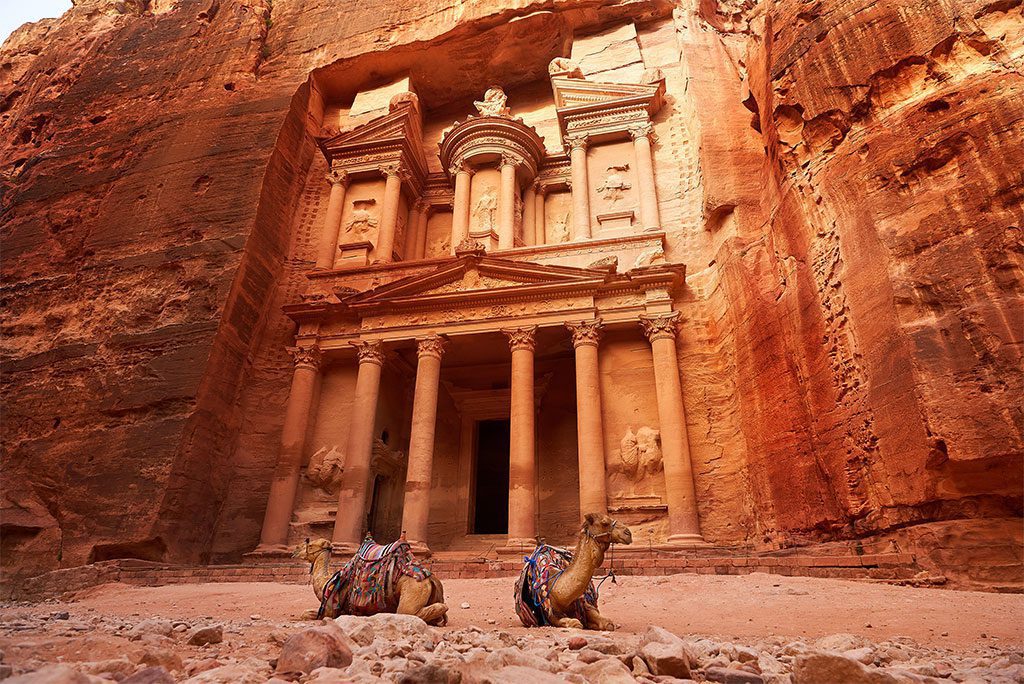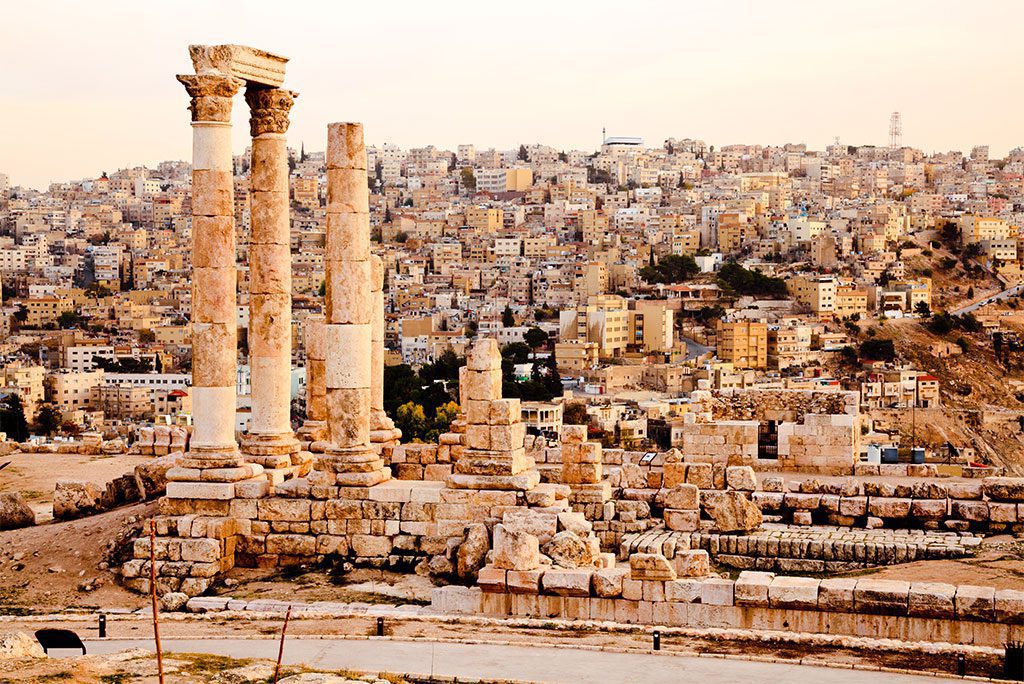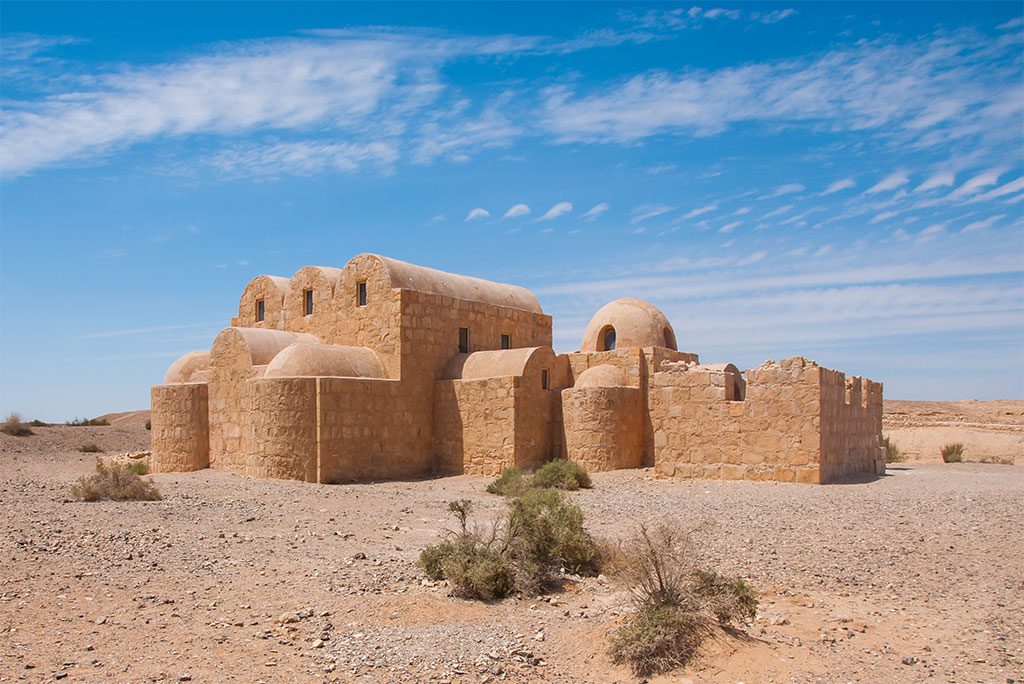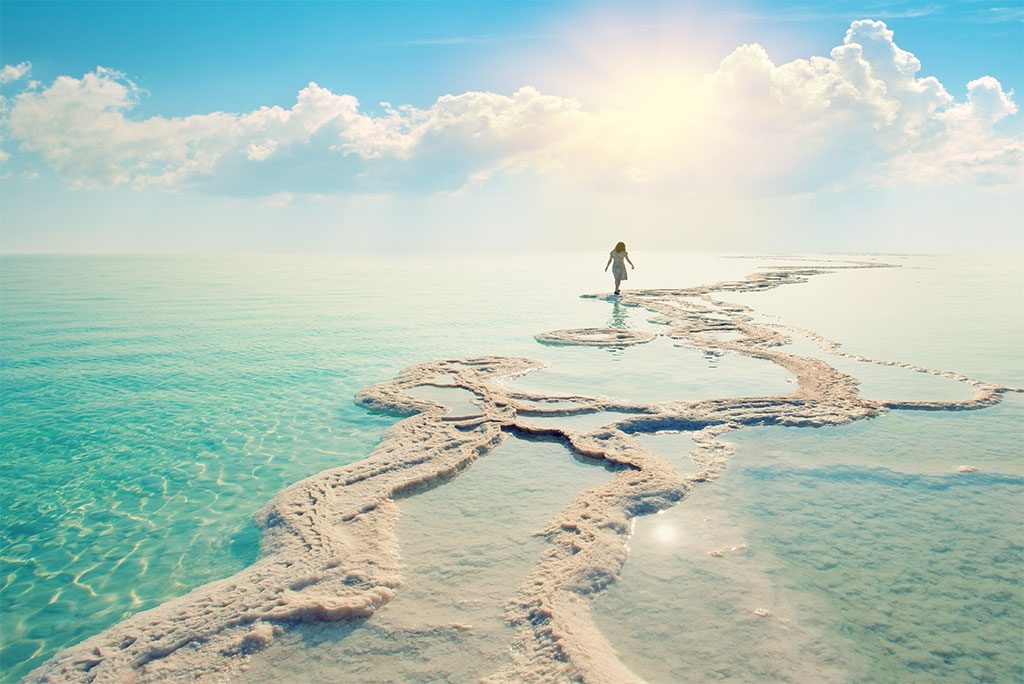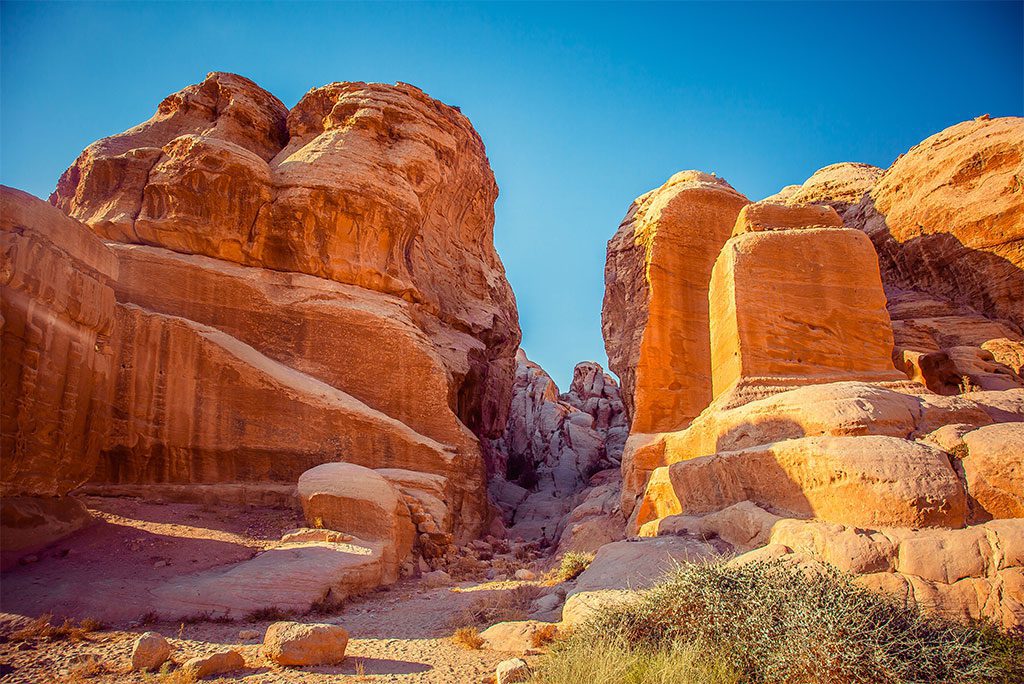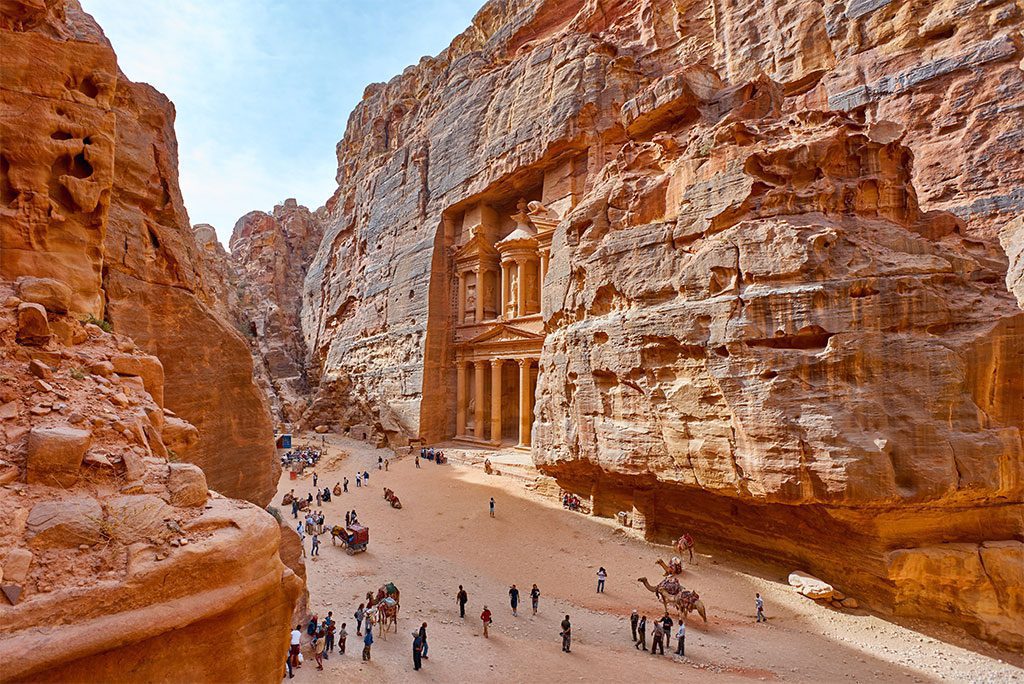Jordan is a landlocked Middle Eastern country surrounded by Syria, Saudi Arabia, Iraq, and Palestine. Jordan is located smack dab in the middle of the Middle East, yet the country tends to seem more liberal, progressive, and safe than some of its neighbours. Those interested in seeing this region of the globe will find it a perfect starting point from which to go on their travels.
Traveling to Jordan allows you to explore historical civilizations, majestic granite cliffs, remote deserts, and even take a dip in the Dead Sea. The Top Tourist Attractions in Jordan:
10. Madaba

Step into the magnificent interiors of the Greek Orthodox Basilica of St. George in Madaba, Jordan. Image source: vvoe/Shutterstock.com
Madaba, a little town just south of the capital, is home to many old religious buildings and works of art. It is most famous for the Madaba Map, a mosaic depicting Jerusalem and other holy locations that dates back to the sixth century. St. George’s Cathedral is home to the Madaba Map.
Visit the Madaba Archaeological Park and the Madaba Museum if you’re interested in the city’s past. Climb the bell tower of the Shrine of the Beheading of Saint John the Baptist for a bird’s-eye perspective of all these landmarks and more.
9. Dana Nature Reserve
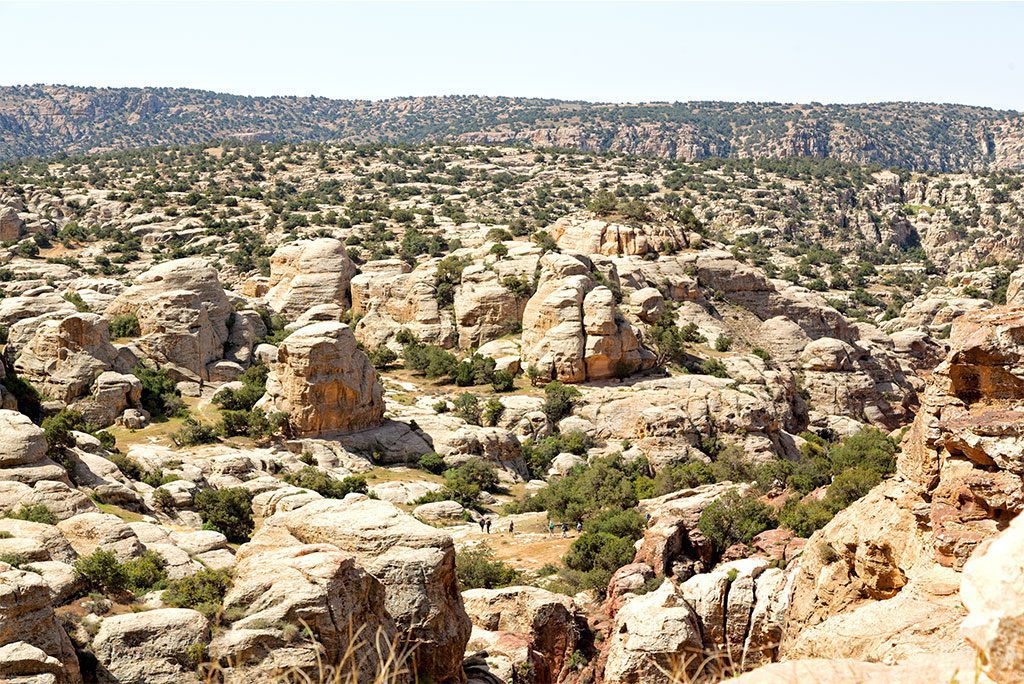
Lose yourself in the breathtaking vistas of Dana Natural Reserve’s picturesque valley. Image source: lkpro/Shutterstock.com
The Dana Nature Reserve is one of the best places in Jordan to go hiking and enjoy the outdoors. The town of Dana, founded in the 15th century and still mostly intact, will serve as your home base and provide you with a few alternatives for lodging and food if you desire to extend your journey there.
Hiking through the Dana Nature Reserve’s slot canyons and valleys is the major attraction for most visitors. The scenery is breathtaking, providing many opportunities for stunning photographs.
8. Aqaba
Aqaba, the only port city in Jordan, is the country’s only other watering hole outside the Dead Sea. Since ancient times, Aqaba has served as a gateway to the Red Sea and a major tourist hub for the country.
The Aqaba Fort, built in the 14th century, may be visited, and contemporary five-star resorts can be found here, making Aqaba a destination with a really unique combination of the old and the modern. The little town of Ayla, which dates back to the sixth century and has been extraordinarily well maintained, deserves special attention. Scuba diving courses and guided dives in the Red Sea are also offered in and around Aqaba.
7. Al-Karak
Al-Karak is an excellent destination for castle enthusiasts. South of Jordan is where you’ll find the city of Al-Karak, also spelled Karak and Kerak. Its large Christian population and spectacular castle have made it famous. The Citadel of Kerak, in the city of Al-Karak, was a Crusader fortress.
The fortress had been pillaged and left in ruins for about 500 years. The castle has undergone some renovation, and visitors may view the renovated areas. The Karak Archaeological Museum may be found on the castle’s lower level, and it has a remarkable collection that sheds light on the region’s past.
6. Amman
Jordan’s capital is Amman, which is also the country’s largest city, cultural centre, and trade hub. Some portion of your time in Jordan will almost definitely be spent in the capital city of Amman. Roman remains abound in Amman, with the enormous Roman Amphitheatre and the Nymphaeum standing out.
There are a number of significant historical buildings in the Citadel, including the Roman Temple of Hercules and the massive stone Ummayad Palace, both of which are well worth seeing. The muezzin’s call to prayer is accompanied by a spectacular show in the city below, which can be seen and heard from the palace.
5. Desert Castles
To the east of Amman, in Jordan’s Eastern Desert, are a number of castles that may be visited. The Umayyads built several of these fortifications and residences for the Kaliffs to utilise as both a defensive stronghold and a place to live. The Umayyads were successful in the harsh desert climate because of their elaborate fortress system.
Many of these fortresses in the desert may be visited in a day’s worth of travel. The Qasr Al-Hallabat black rock and mosaics, the active archaeological site at Hammam as-Sarah, and the amazing paintings at Qasr Amra are all within the loop’s reach.
4. Dead Sea
Despite being completely landlocked, Jordan does have a little bit of coastline on the Dead Sea. At 430 m (1,400 ft) below sea level, the Dead Sea is the lowest location on Earth and contains very high concentrations of salt. The Dead Sea is steeped in history and legend; according to some accounts, it was there that John the Baptist baptised Jesus.
The high salinity of the water makes it simple to float on your back, and the abundance of minerals makes it a wonderful location to unwind. Luxury resorts on the Dead Sea’s northern edge provide the nicest accommodations for visitors. Relax in the spa while taking in the views of the Jerusalem skyline at night.
3. Jerash
Many people’s minds automatically go to European locations when they hear the phrase “Roman ruins.” Jerash, on the other hand, has a fantastic array of Roman and Greek structures. Hadrian’s Arch, which was built in the second century, and the Hippodrome, one of the tiniest Roman hippodromes ever built, are only two of the sights that may be seen by visitors visiting Jerash today.
Beginning your exploration of Jerash with a visit to the Jerash Archaeological Museum is a no-brainer. This museum has an impressive collection of antiquities and does a fantastic job of describing the city’s history and growth.
2. Wadi Rum
Wadi Rum is an absolutely stunning desert valley in southern Jordan. Nomadic tribes and Bedouins periodically travel through this isolated desert area, but no permanent settlements have been established there. And although most people picture sand dunes when they think of a desert, Wadi Rum is really home to sandstone mountains and massive granite cliffs.
Natural landmarks and rock formations, as well as unusual sand or rock hues, are many of Wadi Rum’s primary points of interest. When you see the Umm Fruth Rock Bridge, for example, it’s hard to believe how incredible it is in person.
Numerous science fiction movies (including The Martian) have been filmed in this location in an attempt to capture the fiery orange hues that are characteristic of Mars. Many of the sites associated with Lawrence of Arabia’s stay in Wadi Rum are open to the public, including his home and the nearby natural attraction known as Lawrence’s Spring.
1. Petra
Petra, Jordan’s ancient city and one of the new seven wonders of the world, is not to be missed. Petra, sometimes called the Red City or the Rose City, was the capital of the Nabataean Kingdom until that area was annexed by the Romans. The Western world left the village and forgot about it for generations, but in the 19th century, someone came upon it again.
When you go to Petra today, you may explore the old archaeological site by entering via the Siq, a narrow gorge carved out of the rock. Right after you exit the Siq, you’ll come to the impressive Treasury, which was more likely a temple or a royal tomb than a treasury.
The Roman Theater, the Monastery, and the Street of Façade—a massive canyon lined with the facades of many tombs—are among the noteworthy ruins. Hiking to the Mountain of Aaron will reward you with breathtaking vistas of Petra and its incredible rock-cut buildings.


